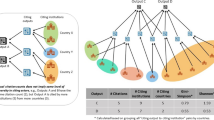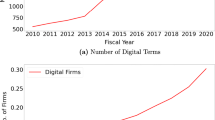Abstract
This paper empirically examines the relationship between research commercialization, entrepreneurial commitment, and knowledge production and diffusion in academia. Through a dataset of 229 academic patent inventors, this paper reveals that the effects of research commercialization on publication quantity, application-oriented research, and disclosure delay are moderated by the entrepreneurial commitment of faculty members. This paper concludes that encouraging entrepreneurial commitment of faculty members may possibly drive academics away from their traditional approaches in producing and diffusing knowledge.
Similar content being viewed by others
References
Argyres, N., & Liebskind, J. (1998). Privatizing the intellectual commons: Universities and the commercialization of biotechnology research. Journal of Economic Behavior and Organization, 35, 427–454.
Azagra-Caro, J. M., de Lucio, I. F., & Gracia, A. G. (2003). University patents: Output and input indicators…of what? Research Evaluation, 12, 5–16.
Balconi, M., & Laboranti, A. (2006). University–industry interactions in applied research: The case of microelectronics. Research Policy, 35, 1616–1630.
Branscomb, L. M., Kodama, F., & Florida, R. (1999). Industrializing knowledge: University–industry linkages in Japan and the United States. London: MIT Press.
Breschi, S., Lissoni, F., & Montobbio, F. (2007). The scientific productivity of academic inventors: New evidence from Italian data. Economics of Innovation and New Technology, 16, 101–118.
Cameron, A. C., & Trivedi, P. K. (1986). Regression analysis of count data. Cambridge, UK: Cambridge University Press.
Chang, Y.-C., Chen, M.-H., Hua, M., & Yang, P. Y. (2005). Industrializing academic knowledge in Taiwan. Research Technology Management, 48, 45–50.
Chrisman, J. J., Hynes, T., & Fraser, S. (1995). Faculty entrepreneurship and economic development: The case of the University of Calgary. Journal of Business Venturing, 10, 267–281.
Cohen, W. M., & Levinthal, D. A. (1990). Absorptive capacity: A new perspective on learning and innovation. Administrative Science Quarterly, 35, 128–152.
Crespi, R. S. (2004). Patenting for the research scientist: An update. Trends in Biotechnology, 22, 638–642.
Dasgupta, P., & David, P. A. (1994). Toward a new economics of science. Research Policy, 23, 487–521.
Di Gregorio, D., & Shane, S. (2003). Why do some universities generate more start-ups than others? Research Policy, 32, 209–227.
Duke, C. R. (1995). Organizational conflicts affecting technology commercialization from nonprofit laboratories. Journal of Product Brand Management, 4, 5–13.
Etzkowitz, H. (1998). The norms of entrepreneurial science: Cognitive effects of the new university–industry linkage. Research Policy, 27, 823–833.
Etzkowitz, H. (2003). Research groups as ‘quasi-firms’? The invention of the entrepreneurial university. Research Policy, 32, 109–121.
Etzkowitz, H., & Leydesdorff, L. (Eds.). (1997). Universities and the global knowledge economy: Triple-helix of university-industry-government relations. London: Printer.
Finkle, T. A., & Deeds, D. (2001). Trends in the market for entrepreneurship faculty 1989–1998. Journal of Business Venturing, 16, 613–630.
Florida, R., & Cohen, W. M. (1999). Engine or infrastructure? The university role in economic development. In L. M. Branscomb, F. Kodama, & R. Florida (Eds.), Industrializing knowledge: University-industry linkages in Japan and the United States (pp. 589–610). London: MIT Press.
Freeman, C., & Soete, L. (1997). The economics of industrial innovation. Cambridge, MA: MIT Press.
Friedman, J., & Silberman, J. (2003). University technology transfer: Do incentives, management, and location matter? Journal of Technology Transfer, 28, 17–30.
Geuna, A. (1999). The economics of knowledge production: Funding and the structure of university research. Cheltenham: Edward Elgar.
Geuna, A., & Nesta, L. (2006). University patenting and its effects on academic research: The emerging European evidence. Research Policy, 35, 790–807.
Godin, B., & Gingras, Y. (2000). The impact of collaborative research on academic science. Science and Public Policy, 27, 65–73.
Hair, J. F., Anderson, R. E., Tatham, R. L., & Black, W. C. (1998). Multivariate data analysis (5th ed.). New Jersey: Prentice-Hall.
Heller, M. A., & Eisenberg, R. S. (1998). Can patents deter innovation? The anti-commons in biomedical research. Science, 280, 698–701.
Hicks, D., & Hamilton, K. (1999). Does university–industry collaboration adversely affect university research? Issues in Science and Technology, 16, 74–76.
Howells, J., Nedeva, M., & Georghiou, L. (1998). Industry-academic links in the UK. Bristol, UK: Higher Education Funding Council for England.
Iversen, E. J., Gulbrandsen, M., & Klitkou, A. (2007). A baseline for the impact of academic patenting legislation in Norway. Scientometrics, 70, 393–414.
Jensen, R. A., & Thursby, M. C. (2001). Proofs and prototypes for sale: The licensing of university inventions. American Economic Review, 91, 240–257.
Lach, S., & Schankerman, M. (2004). Royalty sharing and technology licensing in universities. Journal of the European Economic Association, 2, 252–264.
Lehrer, M., & Asakawa, K. (2004). Pushing scientists into the marketplace: Promoting science entrepreneurship. California Management Review, 46, 55–76.
Louis, K. S., Jones, L. M., Anderson, M. S., Blumenthal, D., & Campbell, E. G. (2001). Entrepreneurship, secrecy, and productivity: A comparison of clinical and non-clinical life sciences faculty. Journal of Technology Transfer, 26, 233–245.
McKelvey, M. D. (1997). Emerging environments in biotechnology. In H. Etzkowitz & L. Leydesdorff (Eds.), Universities and the global knowledge economy: Triple-helix of university-industry-government relations (pp. 60–70). London: Printer.
McMillan, G. S., Dees, D. C., & Narin, F. (2000). An analysis of the critical role of public science in innovation: The case of biotechnology. Research Policy, 29, 1–8.
Merton, R. K. (1968). The Matthew effect in science: The reward and communication systems of science considered. Science, 159, 56–63.
Meyer, M. (2006a). Are patenting scientists the better scholars?: An exploratory comparison of inventor-authors with their non-inventing peers in nano-science and technology. Research Policy, 35, 1646–1662.
Meyer, M. (2006b). Knowledge integrators or weak links? An exploratory comparison of patenting researchers with their non-inventing peers in nano-science and technology. Scientometrics, 68, 545–560.
Mowery, D. C., & Sampat, B. N. (2005). Universities in national innovation systems. In J. Fagerberg, D. C. Mowery, & R. R. Nelson (Eds.), The Oxford handbook of innovation (pp. 209–239). Oxford: Oxford University Press.
Mowery, D. C., & Ziedonis, A. A. (2002). Academic patent quality and quantity before and after the Bayh-Dole act in the United States. Research Policy, 31, 399–418.
Mulkay, M. (1976). The mediating role of the scientific elite. Social Studies of Science, 6, 445–470.
Murray, F. (2004). The role of academic inventors in entrepreneurial firms: Sharing the laboratory life. Research Policy, 3, 643–659.
Murray, F., & Stern, S. (2006). Do formal intellectual property rights hinder the free flow of scientist knowledge?. New York: National Bureau of Economic Research.
National Science Foundation (NSF) (1999). Science and technology indicators: Fiscal year 1999 budget request overview. http://www.nsf.gov/about/budget/fy1999/start.htm.
Nelson, R. R. (2001). Observations on the post-Bayh–Dole rise of patenting at American universities. Journal of Technology Transfer, 26, 13–19.
Nicolas, C., & Mireille, M. (2004). Does research organization influence academic production?: Laboratory level evidence from a large European university. Research Policy, 33, 1081–1102.
O’Shea, R. P., Allen, T. J., Morse, K. P., O’Gorman, C., & Roche, F. (2007). Delineating the anatomy of an entrepreneurial university: The Massachusetts Institute of Technology experience. R&D Management, 37, 1–16.
Owen-Smith, J. (2003). From separate systems to a hybrid order: Accumulative advantage across public and private science at research one universities. Research Policy, 32, 1081–1104.
Owen-Smith, J., & Powell, W. W. (2001). To patent or not: Faculty decisions and institutional success at technology transfer. Journal of Technology Transfer, 26, 99–114.
Powers, J. B., & McDougall, P. P. (2005). University start-up formation and technology licensing with firms that go public: A resource-based view of academic entrepreneurship. Journal of Business Venturing, 20, 291–311.
Raine, J. K., & Beukman, C. P. (2002). University technology commercialisation offices—a New Zealand perspective. International Journal of Technology Management, 24, 627–647.
Sanz-Menéndez, L., & Cruz-Castrol, L. (2003). Coping with environmental pressures: Public research organisations responses to funding crises. Research Policy, 32, 209–227.
Sapsalis, E., van Pottelsberghe de la Potterie, B., & Navon, R. (2006). Academic versus industry patenting: An in-depth analysis of what determines patent value. Research Policy, 35, 1631–1645.
Shane, S. A. (2002). Executive forum: University technology transfer to entrepreneurial companies. Journal of Business Venturing, 17, 537–552.
Shane, S. A. (2004a). Academic entrepreneurship: University spinoffs and wealth creation. Boston, MA: Edward Elgar Publishing.
Shane, S. A. (2004b). Encouraging university entrepreneurship? The effect of the Bayh-Dole Act on university patenting in the United States. Journal of Business Venturing, 19, 127–151.
Siegel, D. S., Waldman, D. A., Atwater, L. E., & Link, A. N. (2004). Toward a model of the effective transfer of scientific knowledge from academicians to practitioners: Qualitative evidence from the commercialization of university technologies. Journal of Engineering and Technology Management, 21, 115–142.
Siegel, D. S., Waldman, D. A., & Link, A. N. (2003). Assessing the impact of organizational practices on the productivity of university technology transfer offices: An exploratory study. Research Policy, 32, 27–48.
Smith, G. V., & Parr, R. L. (2003). Intellectual property: Licensing and joint venture profit strategies (2nd ed.). New Jersey: Wiley.
Sorensen, O., & Fleming, L. (2004). Science and the diffusion of knowledge. Research Policy, 33, 1615–1634.
Thursby, J. G., & Kemp, S. (2002). Growth and productive efficiency of university intellectual property licensing. Research Policy, 31, 109–124.
Valentin, F., & Jensen, R. (2007). Effects on academia-industry collaboration of extending university property rights. Journal of Technology Transfer, 32, 251–276.
Van Looy, B., Callaert, J., & Debackere, K. (2006). Publication and patent behavior of academic researchers: Conflicting, reinforcing or merely co-existing. Research Policy, 35, 596–608.
Verspagen, B. (2006). University research, intellectual property rights and European innovation systems. Journal of Economic Surveys, 20, 607–632.
Wallmark, J. T. (1997). Inventions and patents at universities: The case of Chalmers University of Technology. Technovation, 17, 127–139.
Walsh, J. P., Cho, C., & Cohen, W. M. (2005). The view from the bench: Patents, material transfers and biomedical research. Science, 309, 2002–2003.
Acknowledgment
The authors would like to thank National Science Council, Taiwan (Project Nos.: NSC-96-2627-E-007-001 & NSC96-2416-H-166-002-MY2) for her kind financial support. Two anonymous referees’ insightful and constructive comments are much appreciated.
Author information
Authors and Affiliations
Corresponding author
Rights and permissions
About this article
Cite this article
Yang, P.Y., Chang, YC. Academic research commercialization and knowledge production and diffusion: the moderating effects of entrepreneurial commitment. Scientometrics 83, 403–421 (2010). https://doi.org/10.1007/s11192-009-0075-1
Received:
Accepted:
Published:
Issue Date:
DOI: https://doi.org/10.1007/s11192-009-0075-1




